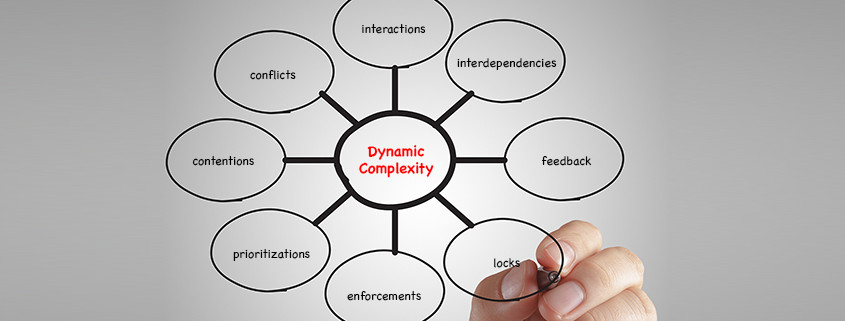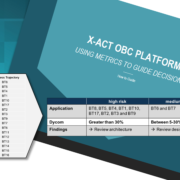Understanding Dynamic Complexity
Complexity is a subject that everyone intuitively understands. If you add more components, more requirements or more of anything, a system apparently becomes more complex. In the digital age, as globalization and rapid technology advances create an ever-changing world at a faster and faster pace, it would be hard not to see the impacts of complexity, but dynamic complexity is less obvious. It lies hidden until the symptoms reveal themselves, their cause remaining undiscovered until their root is diagnosed. Unfortunately, diagnosis often comes too late for proper remediation. We have observed in the current business climate that the window of opportunity to discover and react to dynamic complexity and thereby avoid negative business impacts is shrinking.
Dynamic Complexity Defined
Dynamic complexity is a detrimental property of any complex system in which the behaviorally determinant influences between its constituents change over time. The change can be due to either internal events or external influences. Influences generally occur when a set of constituents (1…n) are stressed enough to exert an effect on a dependent constituent, e.g. a non-trivial force against a mechanical part, or a delay or limit at some stage in a process. Dynamic complexity creates what was previously considered unexpected effects that are impossible to predict from historic data—no matter the amount—because the number of states tends to be too large for any given set of samples.
Dynamic complexity—over any reasonable period of time—always produces a negative effect (loss, time elongation, or shortage), causing inefficiencies and side effects, similar to friction, collision or drag. Dynamic complexity cannot be observed directly, only its effects can be measured.
Static vs. Dynamic Complexity
To understand the difference between complexity (a.k.a. static complexity) and dynamic complexity, it is helpful to consider static complexity as something that can be counted (a number of something), while dynamic complexity is something that is produced (often at a moment we do not expect). Dynamic complexity is formed through interactions, interdependencies, feedback, locks, conflicts, contentions, prioritizations, enforcements, etc. Subsequently, dynamic complexity is revealed through forming congestions, inflations, degradations, latencies, overhead, chaos, singularities, strange behavior, etc.
Human thinking is usually based on linear models, direct impacts, static references, and 2-dimensional movements. This reflects the vast majority of our universe of experiences. Exponential, non-linear, dynamic, multi-dimensional, and open systems are challenges to our human understanding. This is one of the natural reasons we can be tempted to cope with simple models rather than open systems and dynamic complexity. But simplifying a dynamic system into a closed loop model doesn’t make our problems go away.
Dynamic Complexity Creates Risk
With increasing frequency, businesses, governments and economies are surprised by a sudden manifestation of a previously unknown risk (the Fukushima Daiichi Nuclear Disaster, the 2007-2008 Financial Crisis, or Obamacare’s Website Launch Failure are a few recent examples). In most cases the unknown risks are caused by dynamic complexity, which lies hidden like a cancer until the symptoms reveal themselves.
Often knowledge of the risk comes too late to avoid negative impacts on business outcomes and forces businesses to reactively manage the risk. As the pace of business accelerates and decision windows shrink, popular methods of prediction and risk management are becoming increasingly inadequate. Real-time prediction based on historical reference models is no longer enough. To achieve better results, businesses must be able to expose new, dangerous patterns of behavior with sufficient time to take corrective actions—and be able to determine with confidence which actions will yield the best results.









